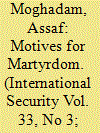| Srl | Item |
| 1 |
ID:
142036


|
|
|
|
|
| Summary/Abstract |
Boko Haram (BH) is an insurgent group that operates mainly in northeastern Nigeria. Its stated aim is to establish an Islamic state, and it employs terrorism as its strategy. Earlier interests of security analysts centred on the drivers of BH uprising and the possibility of its internationalisation. Today's concerns relate more to why the rebellion has lasted this long. In toeing the same line, this article demonstrates that BH is a purposive terror group against which the government has evolved no viable strategy. It examines some gains of BH over the past six years and how it benefitted from the government's underestimation of its capacity and determination. It concludes that to effectively engage BH, the Nigerian government must revaluate its threat and sincerely pursue an expanded strategy beyond the current military-centric approach. To be effective, government's response must be packaged in such a way as to enhance human security in the region.
|
|
|
|
|
|
|
|
|
|
|
|
|
|
|
|
| 2 |
ID:
085681


|
|
|
|
|
| Publication |
2009.
|
| Summary/Abstract |
Suicide missions made their modern debut in 1981. In recent years, however, they have witnessed an unprecedented increase according to several indicators, including number of attacks, number of organizations conducting these attacks, number of countries targeted, and number of victims. Existing explanations, including the occupation and outbidding theses, cannot account for the dramatic increase and spread of suicide attacks. A combination of quantitative and qualitative methods, including analysis of a data set of 1,857 suicide attacks from December 1981 through March 2008, suggests that two interrelated factors have contributed to the "globalization of martyrdom": al-Qaida's evolution into a global terrorist actor and the growing appeal of its guiding ideology, Salafi jihad. As localized patterns of suicide missions have given way to more globalized patterns, states must rethink their counterterrorism strategies. At the same time, because Salafi jihadist groups tend to target Muslims, moderate Muslims and nonviolent Salafists must take the lead in challenging these groups.
|
|
|
|
|
|
|
|
|
|
|
|
|
|
|
|